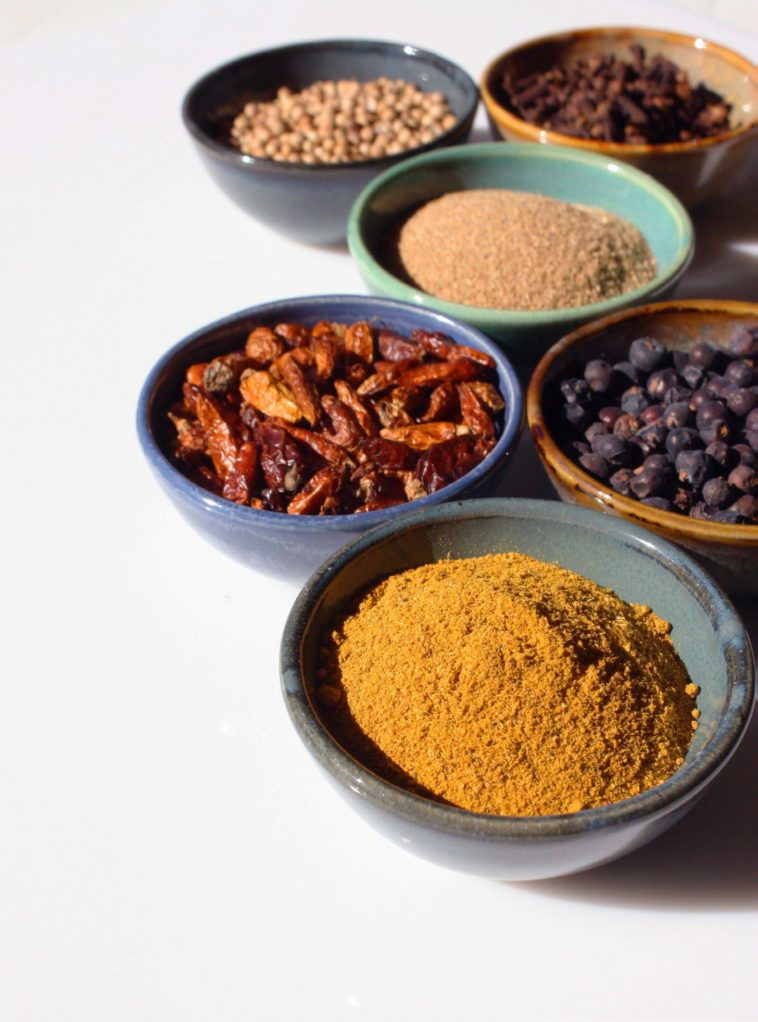Southern African farmers are well known for the regular economic challenges they have to face. These realities force them to search for new options of surviving and expanding their businesses. One of the many opportunities to grow markets, turnover and profits is by adding value to farm produce. Options need to be carefully selected, based on sound information and knowledge of the opportunities presenting themselves on a regular basis, seen in light of the strengths and weaknesses of individual farms.
Food processing takes place on various scales: small-scale processing usually takes place in the household kitchen whereas larger scale food processing is done in factories and bakeries. However, regardless of the scale of food processing being undertaken, the processes involved are the same. These processes are known as unit operations and are carried out in sequence as illustrated by the example flow diagram below:
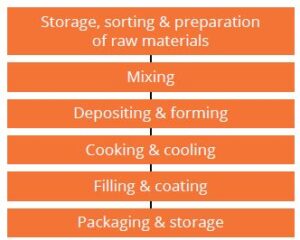
Process flow of the individual unit operations of a food product.
The aim of this series is solely to provide the reader with some basic information on food processing in order to realise the extent of the operations involved. This information concentrates on the sequence and steps involved in the processing of the selected products and explains the reasons for and necessity of each step.

Mango achar production. Photo: idcbackup.co.za.
The needs and values of every individual processing entrepreneur differ and can only be addressed properly by a team of experts. Therefore, this series serves as a starting document from which the interested entrepreneur can gain insight into the extent of operations and from where some relevant designers and suppliers can be sourced. It also aims to encourage farmers to delve deeper into the topics of interest where other material with more complete information on calculations, designs, legal aspects, national or local laws, quality management, marketing and financing can be found.
A condiment can be defined as a spice, sauce, or other preparation that is added to a food product to impart a certain flavour, or to enhance the existing flavour of the product. It may also be used to compliment the dish. The word has its origin in two Latin words:
Condiments are available in many forms and used at various stages of cooking and product preparation for example single-serving packets such as ketchup, supplied with fast-food meals. They may be applied during dinner or prior to serving a meal or used during the cooking process to add flavour or texture to the final dish, and include seasonings such as herbs, various spices, salt and pepper.
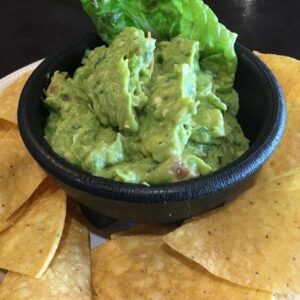
Avocado guacamole. Photo: Michael Shivili from Pixabay.
The condiments and seasoning covered by this series include:
Mango achar: Green mangoes with premature soft seeds are suitable for achar or oil pickles. Achar is very popular with a large part of the Southern African population. It is eaten with maize, porridge or bread as a substitute for meat and also serves as an aromatic flavouring with other foods. Owing to its high oil content, achar has a high nutritional value. The oil used is either mustard or gingerly oil. Cured green mango slices are drained, mixed with spices and oil, and filled into suitable containers and sealed. Extra oil is added at the top to prevent air entry. High acid mangoes (5 to 6%) were found to produce the best quality achar.
Peach chutney: Chutney is a sweet, tangy condiment that is served with curries, hot and cold meats and savouries. Peach chutney may be prepared from both green and ripe peaches, along with other fruit/vegetables such as onions and green peppers, sugar, vinegar and various spices and thickening agents. It is packaged in glass bottles and has a shelf life of several months at cool temperatures.
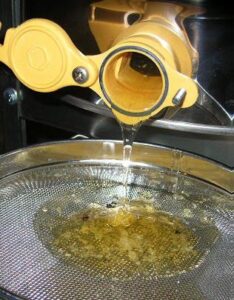
Filtering honey. Photo: greenmountaingreenery.blogspot.com.
Tomato chutney: Similar in style to peach chutney, tomato chutney may be prepared from both green and ripe tomatoes, along with onion, sugar, vinegar and various other ingredients, including spices.
Ginger oil: Dried ginger is used for the preparation of ginger oil. Ginger oil has an aromatic, lemony, spicy and mildly pungent sensory character and is used in the flavouring of beverages, confectionary and in perfumes.
Avocado guacamole: Guacamole is a dish of mashed avocado mixed with chopped onions, tomatoes, chilli peppers and seasoning.
Raw honey: Raw honey refers to honey as it exists in the beehive and which has been obtained by extraction, settling or straining, without the addition of any kind of heat to the product. This type of honey contains some pollen, and may even contain small fractions of beeswax.
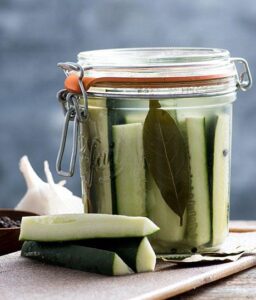
Fermented cucumber pickles. Photo: frontiercoop.com.
Strained honey: Strained honey is produced by passing raw honey through a mesh which removes particles without removing pollen, minerals or enzymes.
Filtered honey: Filtered honey has been processed to the point where all or most of the fine particles, pollen grains, air bubbles, or any other material that is usually found in suspension in raw honey, has been removed.
Olive oil: Virgin olive oil is the oil extracted by mechanically pressing the fruit without using any heat. It may have a slight off-flavour, “olive-fruity” and may contain acid up to 0,3 to 0,6%. Extra virgin olive oil is oil where the oleic acid content does not exceed 1%. Fine virgin olive oil is oil where the oleic acid content does not exceed 1,5% and the flavour is perfect. Semi-fine or ordinary virgin oil is oil where the maximum acidity is 3,3%. If the acidity of the oil is above 3,3%, the oil is not fit for human consumption and is used as lampante olive oil.
Piccalilli: Pickles generally fall into two categories, namely clear pickles and thick, saucy pickles such as piccalilli. Pickled vegetables are preserved by the addition of acid, salt and sugar. A wide variety of sweet pickles are available, varying with the vegetables used, the degree to which the vegetables are softened by cooking and the type of sauce used. The texture of the vegetables thus varies from crisp to soft. Common vegetables include cauliflower, carrot, celery, tomato, cucumber and onion. Spices include salt, turmeric, mustard, ginger, garlic, and red chillies. A wide range of recipes are available, reflecting different approaches and ideas, different consumer preferences, different preparation methods and equipment and economic considerations. This is therefore a very basic description of the preparation and preservation of a thick, saucy pickle. The manufacturer or would-be manufacturer can develop his own unique product with the principles discussed in this method. The vegetables and the sauce are prepared separately and combined just before filling. The vegetables may be cooked slightly in the sauce. The ratio of sauce to vegetables varies between 4:5 and 6:4. A refractometric solids content of 35% and an acetic acid content of 2,4% provide both a satisfactory sugar/acid flavour combination and a safe preservation index.
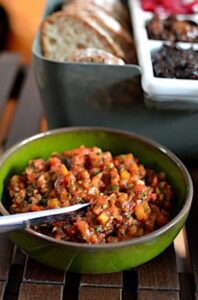
Bell pepper salsa. Photo: thewindmill-bakery.com.
Fermented cucumber pickles: Fermented pickles or brined pickles undergo a curing process for several weeks in which fermentative bacteria produce acids necessary for the preservation of the product. These bacteria also generate flavour compounds that are associated with fermented pickles. Initial fermentation may be followed by the addition of acid to produce such products as half dills or sweet gherkins.
Fresh-pack cucumber pickles: Fresh-pack or quick process pickles (i.e. whole cucumber dills, crosscut cucumber slices, bread-and-butter pickles) are made by the addition of an acid such as vinegar and not by the natural fermentation of the vegetables. The tart flavour of these easily prepared products is due to the acetic acid in vinegar. The product is further preserved by pasteurisation.
Pickled onions: Small onions are peeled and stored in brine (salt solution) to facilitate natural fermentation of the product. The fermented onions are then packed and preserved in vinegar liquor to produce pickled onions. Suitable onions for pickling include brown (28 to 45 mm) and silver-skin, pearl or cocktail (10 to 28 mm) onions.
Pickled bell pepper: Peppers can easily be pickled in a brine or vinegar solution, alone or with other vegetables and seasoning. The variety of coloured peppers available make attractive pickles. Certain varieties can be pickled as whole pods, while larger peppers are cut into strips.
Bell pepper salsa: Bell peppers can be preserved in the form of a sauce known as salsa. Salsa is a spicy sauce that is served with meat and Mexican food. It is best served fresh, but can be frozen for later use. However, frozen salsa does not have the same consistency as the fresh product. Peppers are chopped with tomatoes, onions, garlic and spices such as fresh parsley, basil or oregano. Interesting varieties can also be made by the addition of chilli and various fruits such as papaya and pineapple.
Sauerkraut: Sauerkraut is made from shredded cabbage leaves preserved through an acidifying fermentation process. Sauerkraut is produced from both hard white or red cabbage varieties.

Tomato sauce. Photo: Menno de Jong from Pixabay.
Tomato sauce (ketchup): Ketchup is made from strained, pulped tomatoes and additions such as spices, salt, sugar, vinegar, onions, garlic and contains no less than 12% tomato solids. The principles of manufacturing ketchup are based on the preparation of a tomato puree or paste. The percentage of tomato solids in the final formulation (that is yield) is related to the insoluble cellular materials released during pulping.
Apple cider vinegar: Vinegar is the sour liquid obtained by naturally fermenting the juice of any fruits, cereals or sugar substances. Apple vinegar is produced by alcoholic fermentation followed by acetous bacterial oxidation of apple juice. Apple vinegar should contain between 5 and 12% acetic acid. Apple cider vinegar is produced from apple juice or diluted concentrate.
Grape vinegar: Vinegar is the sour liquid obtained by naturally fermenting the juice of any fruit, cereal or sugar substance. Fermented grape juice, that is wine, is used as the starting material to which the vinegar plant (yeast culture) is added. The wine undergoes an acetic fermentation by micro-organisms of the Acetobacter spp. which converts the alcohol to acetic acid.
Barbeque sauce: During barbeque style cooking, barbeque sauce is used as a flavouring sauce, marinade, or basting for pork, beef and chicken. Barbeque sauce is a ubiquitous condiment that can be used on many other foods as well. The ingredients of barbeque sauce vary depending on the recipe and may even vary within different countries. The usual accepted ingredients however are vinegar, tomato paste (or mayonnaise or both) for the base of the sauce, and then liquid smoke and spices such as mustard and black pepper, and sweeteners such as sugar or molasses.
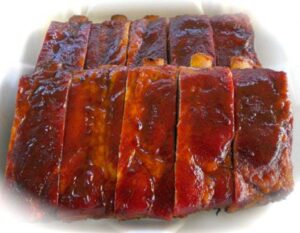
Barbeque sauce on pork ribs. Photo: Laura Sweat from Pixabay.
Cheese sauce is based on white sauce, which is known as the ‘mother of sauces’ and is produced by adding a suitable cheese to white sauce and then flavouring the sauce with, among other ingredients, mustard, Worcestershire sauce and pepper.
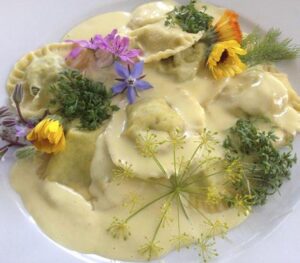
Cheese sauce on ravioli. Photo: Sophie Janotta from Pixabay.
Published with acknowledgement to the ARC Agricultural Engineering for the use of their manuals. Visit www.arc.agric.za for more information.

